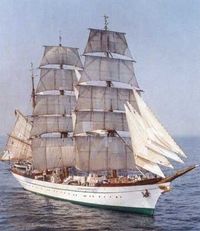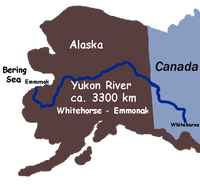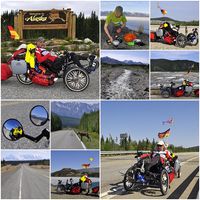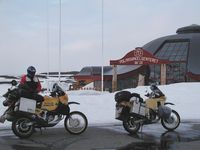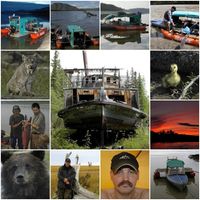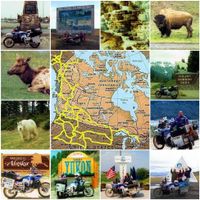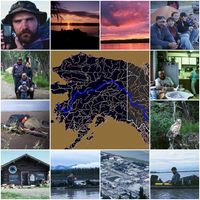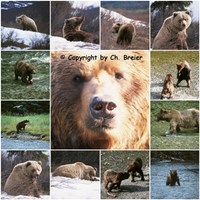Norman Wells - San Sault Rapids - Rampart Canyon - Fort Good Hope - Arctic Circle - Tsiigehtchic
Norman Wells, with a population of 798 (as of 1996), is also called by the traditional name of Legohli (meaning "where is the oil") and is located at 65°17'N lat. and 126°50'W long., on the middle course of the Mackenzie river. Local languages are North Slavey and English, and the community belongs to the electoral district and land claim area of Sahtu
The Norman Wells oil field is Canada's fourth largest producing oil field in terms of remaining reserves, with estimated ultimate recoverable reserves of 37.5 million cubic metres. Norman Wells production in 1993 was 1.8 million cubic metres of oil and 134 million cubic metres of natural gas. Cumulative oil production reached 19.5 million cubic metres. Imperial Oil drills twelve wells in 1994-95 at a cost of $30 million. Production is expected to continue until about 2020.
Oil well
Proud History unlike most other communities along the Mackenzie River, which originated as fur trading posts, Norman Wells was the first community in the NWT established solely as a result of non-renewable resource development.
Deep within the earth, beneath the glacial deposits and alluvial sands, gravels, and clays of the Mackenzie Valley, there lies a thick layer of sedimentary rocks, sandstone, shale, and limestone. Reefs and sediments laid down in shallow seas and vegetation-clogged swamps millions of years ago, now produce oil which seeps to the surface along river banks.
These oil seepages gave rise to the Dene name for the area, "Le Gohlini," meaning "where the oil is." Alexander Mackenzie noticed oil seepages when he traveled the river at the end of the 1700's. Dene from the area led geologists to the same spot in the early 1900's. Three claims were staked in 1914.
Imperial Oil acquired the claims in 1918, and the discovery well was drilled in 1919 by Ted W. Link. A small refinery was built in the early 1920s, and supplied downriver communities for about 50 years. But demand, and production, was small until the 1930's, when new mining activities started at Port Radium and Yellowknife, NWT.
During World War II, the US government became very concerned with possible Japanese attacks on west coast petroleum facilities. The US Army undertook a rush construction program, completing a pipeline from Norman Wells to Whitehorse over the winter of 1943-44. This route is known as the Canol Trail. By the time the pipeline was completed, the Japanese threat to Alaska had receded, and cheaper oil supply routes could be used, so the pipeline was turned off and dismantled in 1947.
After the war, the size of the Norman Wells operation was governed by the rate of expansion of the mining industry. In the mid-1980's, a pipeline was completed to Zama, Alberta.
In the meantime, Norman Wells has also become an important regional business and tourism centre. In the summer, the Norman Wells airport serves as a base for forest fire-fighters in the region.
Another major chapter in the region's history was written in 1994, when the government of Canada and the Sahtu Tribal Council signed the Sahtu Land Claim Agreement. The Sahtu Tribal Council represents the Hare, Sahtu Dene, Mountain Dene, and Metis people of the region. The agreement recognizes Sahtu ownership of major land parcels within the region, and provides financial compensation and royalty shares for use of other lands in the region.
The San Sault Rapids (Smelly Rapids) Below Norman Wells, the Mackenzie narrows to about 1 kilometre, and a rocky ledge extends into the midstream.
The Rampart canyon. Just upstream from Fort Good Hope, canoeists must follow the channel markers through the Mackenzie's most spectacular gorge. The long, vertically-walled limestone cliff extends for 12 kilometres.
With Orca in the Rampart canyon
We found a nice campspot at the end of the canyon
The Moon over the Ramparts
Fort Good Hope is the oldest settlement in the lower Mackenzie Valley. Although established in 1805 by the Northwest Company, Fort Good Hope moved several times before it reached its current location, chosen in 1839.The two principal languages are North Slavey and English. Hunting and trapping are two major sources of incomeThe only access is by air and by shipping along the Mackenzie River. The NWT government is seeking federal funding to help extend the Mackenzie Highway from Wrigley to Tsiigehtchic, where it would connect with the Dempster Highway.
The inside of ORCA, lots of electronics
Nice calm day on the Mackenzie River
The Arctic Circle, incidentally, is an imaginary line located at 66, 33'N latitude, and as a guide defines the southernmost part of the Arctic. The Arctic Circle marks the southern extremity of the polar day (24 hour sunlit day, often referred to as the "midnight sun") and polar night (24 hour sunless night). North of the Arctic Circle, the sun is above the horizon for 24 continuous hours at least once per year, and below the horizon for 24 continuous hours at least once per year. On the Arctic Circle these events occur, in principle, exactly once per year, at the June and December solstices respectively. It is called the Arctic because it is corresponds to the southernmost point of the Constellation Ursa Major (the Great Bear or Megas Arktos in Greek).
Nothing special at the arctic circle...
Recently the region north of the Arctic Circle has gained significant international attention due primarily to global warming. Initial attention came as a result of the fact that the earth's poles are the points at which the planet tends to warm the fastest thereby acting as harbingers of what is to come. At a more practical level, though, the melting of the ice in the Circle is making the Northwest Passage, the shipping routes through the northern-most latitudes, more navigable, raising the possibility that some day the Arctic region could become a prime trade route.....
I really like ORCA she is a very good expedition boat...
Town of Tsiigehtchic
Tsiigehtchic is a community of less than 200 persons located at the confluence of the Mackenzie River and the Arctic Red River. Formerly called Arctic Red River, the community officially changed its name to Tsiigehtchic (Mouth of Iron River) in 1994 to honour it's traditional name. This location has a very long history as a summer fish camp for the Gwichya Gwich'in ("people of the flat lands") and was the site of many gatherings and trade (both friendly and not so friendly) between the Gwichya Gwich'in, Slavey and Inuvialuit.
As long as anyone can remember, the Gwichya Gwich'in traveled up the Arctic Red River into the mountains along the Yukon NWT border, in late summer. There they lived and hunted through the winter. When the river opened in spring, they returned to their fishing grounds at Tsiigehtchic and other places along the Mackenzie River for the summer.
Missionaries established a Roman Catholic church in the area in 1868, however some families continued to winter in the mountains until the 1960s. Construction of the Dempster Highway in the 1970s brought wage employment, and some community members operate the ferry which carries summer traffic across the Mackenzie and the Arctic Red Rivers.
Orca in the mouth of the Arctic Red River at the town of Tsiigehtchic.
The Arctic Red River traverses extremely diverse terrain. It is a mountain river for the first third of its length, descending through the barren Mackenzie Mountains and gathering flow from rain, sun-warmed snow, and melting glaciers. It appears as a canyon river through its middle reaches, having incised an impressive canyon and valley system through the uplifted Peel Plateau. In its final stages, the Arctic Red is a slow, sediment-laden river, flowing across the Mackenzie Lowlands towards its junction with the Mackenzie River.
Next: The Mackenzie Delta
Only those who risk going too far, will discover how far they can go!
Expedition in USA, Alaska & Canada, Scandinavia with folding boat, motorboat, catamaran, motorcycle, off-road vehicle, bicycle ...

























